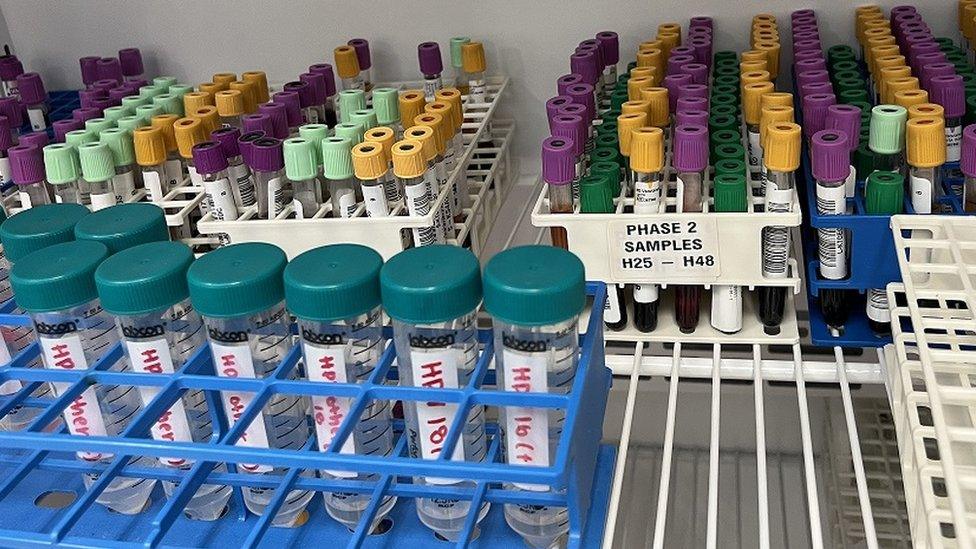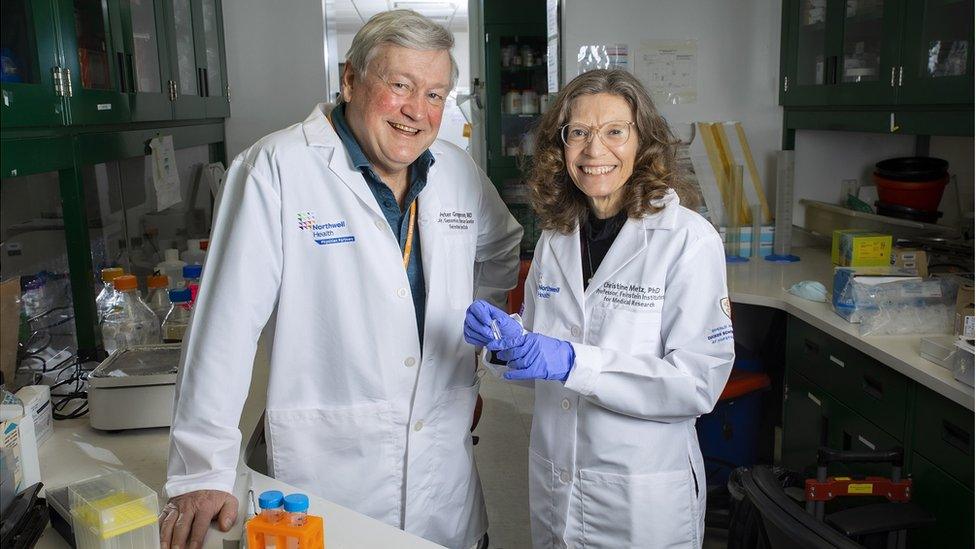The firms that want to test menstrual blood
- Published

Life science firm Qvin wants to test menstrual blood
On any given day, about 800 million people, external around the world are on their period.
Given those numbers, surprisingly little is known about menstrual blood itself.
Sara Naseri, a doctor, hopes to change that with her healthcare start-up Qvin. She believes that testing this largely-ignored monthly blood sample could offer ground-breaking new health insights.
But it's been challenging developing technology in this area, as there has not been much research conducted on menstrual blood.
While still in medical school, Dr Naseri could find only one study on menstrual blood, a 2012 paper that described its composition and structure and found 385 proteins that are unique to menstrual blood.
As well as blood, menstrual effluent contains vaginal secretions, cervical mucus, and endometrial cells. The endometrium is a membrane that lines the uterus and thickens every month to support embryo implantation. If pregnancy doesn't occur, this lining is shed through the vagina.
"Blood is the most commonly-used bodily fluid for medical decision-making," says Dr Naseri. "I thought: 'Women bleed every month. Why has nobody used this blood for health purposes?'"

Qvin co-founder Sara Naseri believes menstrual blood could be used for health purposes
The team at Qvin are trying to bridge the research gap by conducting a broad range of studies.
Initial results have been promising. Qvin's research has shown that menstrual blood can be used to monitor blood sugar, external and cholesterol levels, external.
Using that research, Qvin has developed a pad that can be used to test menstrual blood. It is currently being assessed by US health regulators.
Future potential lies in finding non-invasive ways to diagnose and treat conditions that affect the female reproductive system.
A lack of research into female reproductive diseases has resulted in slow diagnosis times, relatively few treatment options, and tests that are often painful and distressing for the patient.
In the UK, just 2.1% of medical research, external funding goes to reproductive conditions, despite research showing that 31% of women experience severe issues, external with their reproductive health.
Less than half of those affected will seek medical help.
As well as a lack of research and precedent, seeking to test menstrual blood means negotiating a lot of resistance and societal taboos.
Berlin-based start-up Theblood struggled to find a lab partner that would agree to analyse menstrual blood samples.
"We have to do everything from scratch, from the very, very start. Labs will test saliva, urine, or stool samples but there's just nothing for menstrual blood," says Theblood co-founder Miriam Santer.

Peter Gregersen and Christine Metz are co-directors of the Rose study
Dr Christine Metz, a professor and endometriosis researcher at the Feinstein Institutes for Medical Research at Northwell Health on Long Island, New York, believes that a "yuck factor" is a large part of the reason there's been so little research into period blood.
"When we set out to collect menstrual effluent to study it, I had several physicians tell us that they can't ask their patients to do that," she says. "[But when] we [put a call out on] social media, we got 6,000 people in our registry. Obviously, they got beyond the yuck factor."
Testing menstrual blood has never been part of clinical gynaecology practice.
Endometriosis is one of the most common gynaecological conditions. It's extremely painful and occurs when tissue that normally lines the uterus grows on the outside of other organs in the pelvic cavity. It affects roughly 10% of women and girls. Diagnosis can take up to 12 years and can only be confirmed through surgery.
There are currently no effective treatments for endometriosis.
Things are slowly getting better thanks in part to awareness raised by prominent advocates like Lena Dunham and Padma Lakshmi, external.
Nevertheless, pain is currently treated with hormones that can have severe side effects and even a hysterectomy does not guarantee the removal of endometriosis lesions.


Christine Metz is part of a team running the Rose (Research Outsmarts Endometriosis) study which is looking into menstrual effluent in an effort to speed up diagnosis times and develop treatments for endometriosis.
Getting funding for studying menstrual blood has been hard to come by. "I'm told all the time: 'Oh, you should work in cancer. There's so much more money.' And it's true. There's just no money available for this. It's worth fighting all the time to get a dime but it's very, very, very difficult," she says.
Companies like Qvin and Theblood are paying for their studies with venture capital funding, in the hope that that the fastest way to drive change may be through demonstrating that menstrual blood tests have value as a consumer product.
However, each admits that pitching to investors often means explaining the very basics of menstruation, like how tampons, sanitary pads, and menstrual cups are used.

Theblood team, Miriam Santer and Isabelle Guenou, struggled to find a lab partner to analyse menstrual blood.
Home-testing solutions would make testing for some conditions far more convenient.
Ashley Draper, a 36-year-old from Washington DC, took part in a Qvin study that aimed to assess if menstrual blood could be used to screen for cervical cancer after responding to an Instagram ad.
For over ten years, abnormal smear test results have required Ms Draper to go in for cervical cancer checks every 6 months.
During a cervical cancer test, a doctor will use a speculum to open the vagina and insert a small brush or spatula to scrape cell samples from the cervix at the entrance to the uterus. Pain relief is generally not offered.
"It's obviously a very invasive process," says Ms Draper. "Although you're there to work with the doctor..., as far as going through the process itself, you kind of feel just like a slab of meat on a table. It just seems like they're using very archaic processes."
Reducing the high cost of care and feeling more in control of health outcomes is also appealing to Ms Draper. "For me, it's just a win overall if this becomes a product because it will reduce my anxiety and will give me more control over what's going on with the testing."

Sign up for our morning newsletter and get BBC News in your inbox.
